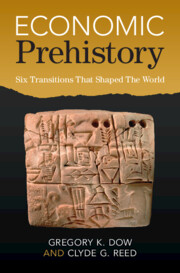Book contents
- Economic Prehistory
- Economic Prehistory
- Copyright page
- Dedication
- Contents
- Figures
- Tables
- Preface
- Acknowledgments
- Abbreviations
- Part I Prologue
- Part II Sedentism and Agriculture
- 3 The Upper Paleolithic
- 4 The Transition to Sedentism
- 5 The Transition to Agriculture
- Part III Inequality and Warfare
- Part IV Cities and States
- Part V Epilogue
- References
- Author Index (Abridged)
- Subject Index
3 - The Upper Paleolithic
from Part II - Sedentism and Agriculture
Published online by Cambridge University Press: 10 February 2023
- Economic Prehistory
- Economic Prehistory
- Copyright page
- Dedication
- Contents
- Figures
- Tables
- Preface
- Acknowledgments
- Abbreviations
- Part I Prologue
- Part II Sedentism and Agriculture
- 3 The Upper Paleolithic
- 4 The Transition to Sedentism
- 5 The Transition to Agriculture
- Part III Inequality and Warfare
- Part IV Cities and States
- Part V Epilogue
- References
- Author Index (Abridged)
- Subject Index
Summary
Our study of economic prehistory begins with mobile foraging in the Upper Paleolithic. Foraging bands can obtain food from various natural resources. At a given point in time, some resources are actively exploited while others are latent. Social learning improves techniques specific to the exploited resources but with diminishing returns over time. Societies can experience lengthy periods of technological stagnation where latent resources are not used due to inadequate techniques, but techniques do not improve because these resources are not used. A positive climate shift can increase the standard of living in the short run, generating population growth in the long run. Agents then exploit previously latent resources, broadening the diet. Once new resources are in use, learning by doing raises productivity in the very long run, causing more population growth, until a new equilibrium is reached with an increased population and wider diet. The expansion of technological knowledge creates a ratchet effect where a return to the original climate regime need not imply that population or diet breadth will return to their initial levels. These mechanisms can explain how humans migrated into more severe environments over time without reference to resource depletion due to overharvesting.
Keywords
- Type
- Chapter
- Information
- Economic PrehistorySix Transitions That Shaped The World, pp. 67 - 109Publisher: Cambridge University PressPrint publication year: 2023

